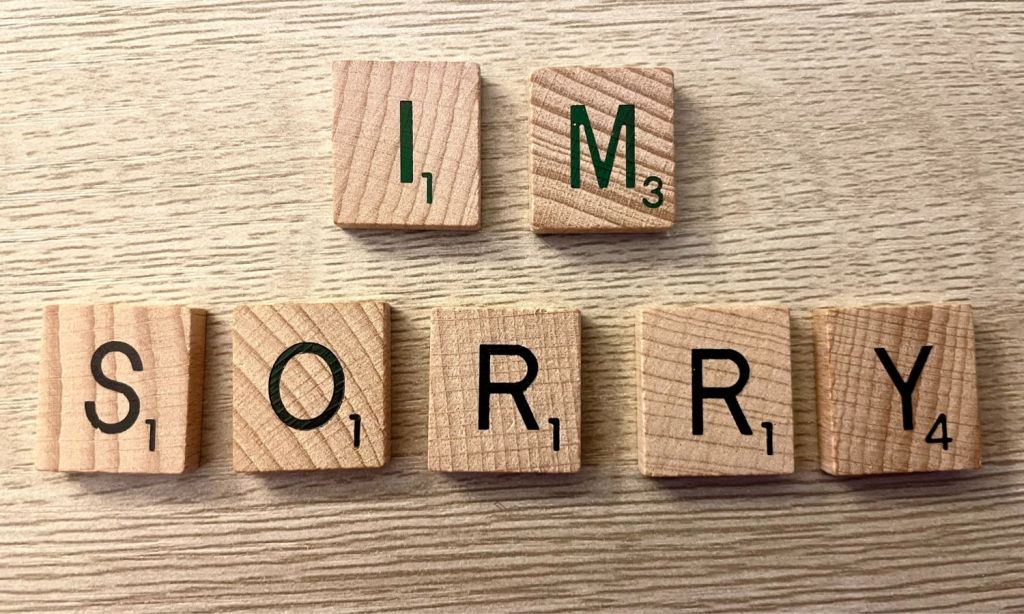It can be hard to find the right words to apologise, particularly in a professional setting. You might not want to labour over the fact you made a mistake, which might undermine your authority. Or you might not even be sure if you need to apologise at all, especially if it’s clear you won’t do it again, or there’s no reason to say ‘sorry’.
Ahead, Shona Hendley, an Australian journalist who has heavily researched and written about apologising, shares her tips for how to best apologise in a professional setting. You can catch her on a new episode of Insight, Sorry, Not Sorry, on Tuesday, August 29 at 8:30pm on SBS or SBS On Demand.

When You Shouldn’t Apologise at Work
Firstly, when should you apologise? Hendley says she often sees people apologising at work when it isn’t warranted. She suggests assessing whether an apology is warranted before jumping in with ‘I’m sorry’.
“As an over-apologiser myself, I have done this for as long as I can remember, but it was actually at work that I started to dial it back more effectively,” says Hendley. “I was able to establish more easily whether I had made a mistake or needed to acknowledge that, or whether it was something, like raising an opinion, that didn’t constitute saying ‘sorry’ for.”
The idea that you need to apologise for speaking up or sharing your opinions is something many of us can get wrong about apologising at work, she says.
For example, interjecting in a meeting to say, ‘Sorry, but I’d like to add something to that’. That, Hendley says, doesn’t warrant an apology because you are simply adding to a conversation or discussion, even if it is with an opposing opnion. In fact, in most cases, it should be welcomed.
How to Correctly Apologise at Work
When when you’re apologising, it’s best to be genuine and sincere as most people can see right through a fake apology, says Hendley. If anything, a disingenuous apology only makes the situation worse. Also, own up to your mistakes in a timely manner, and be clear on what you’re apologising for.
“I think understanding the culture of your specific workplace is also critical and ensuring that when and where you apologise aligns with this shows respect for the organisation,” says Hendley. “For example, some employers would prefer a written apology, while others may value one done in person. I’d generally avoid a text or social media apology for work-related issues.”
As for the framework for apologising, Hendley outlines the below:
Acknowledge What Happened
“I think an apology can be kept simple and still be sincere,” she says. “Actually, saying the words, I am sorry is key, and then following up with what it is you did wrong and how you will fix this or learn from it.
“For example, ‘I made a mistake in the article about trees. I thought I had fact-checked this point, but I can see now that I didn’t do this. I’m so sorry, and it won’t happen again. To fix it, I have updated the article with an amendment statement at the end to ensure readers know that this occurred, but if you’d like to discuss this further, I am open to this. Please let me know a suitable time’.”
State Your Mistake
When you’re apologising, it’s also important to state your mistake specifically, so that whoever you are apologising to knows you are aware of it and why your actions were wrong. Also, be careful with your language, always ensuring you’re respectful and professional, and avoiding humour and sarcasm.
“Another super important thing to remember is not to avoid adding in justifications or deflections for why you made a mistake,” says Hendley. “The ‘I’m sorry but I did it because…’ sort of statement really defeats the purpose of apologising in the first place.”
“The same goes for ‘I’m sorry if you got upset because of….’ That isn’t taking ownership of your actions it almost puts the blame on the victim or person who was impacted by your mistake, and they show no remorse whatsoever. I had a manager say that to me once and, as an employee, I felt completely unseen and disrespected, as if they were saying it to tick a box, not because they meant it.”
Take Corrective Action
Finally, following up on an apology with corrective actions shows that your apology was sincere and that, as a professional, you have grown from the mistake, says Hendley.
“Seeking feedback or input from colleagues around the mistake that was originally made can also be a great way to really show your eagerness to learn from your mistake and make good on your apology,” she says. “It really shows gratitude for feedback and forgiveness — another important part of an apology — too.”
Related: Boundaries vs. Ultimatums: What’s Better For Your Career?
Related: How the 80/20 Leadership Method Could Level-Up Your Career
Read more stories from The Latch and subscribe to our email newsletter.


